Browse Exhibits (27 total)
2021 Immersive Learning Faculty Awards
Ball State University’s Offices of the Provost, Vice Provost of Academic Affairs, and Immersive Learning are pleased to announce the 2021 Immersive Learning Faculty Awards.
The purpose of these awards is to recognize demonstrated excellence in creating, mentoring, and implementing these courses. This event celebrates not just our award winners but also every individual who is involved in community-engaged, high-impact activities. We appreciate all that you do to promote immersive learning on our campus and in the community.
This year's immersive learning awards celebrate some of Ball State's most impactful projects taking place from January 2019 to July 30, 2020, and the four awardees will receive a $1,000 financial stipend. We extend a special thank you to the past award recipients who served on our review committee: Annette Rose from Educational Studies, David Largent from Computer Science, and Carolyn Dowling from Geological Sciences.
To see the official, recorded announcement, click on the exhibit video.
To read more about the faculty winners and their projects, click on the pages listed in the right side bar.
Conservation Tales Immersive Learning Project
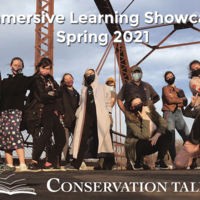
Conservation Tales is an interdisciplinary team of students and faculty who work with a variety of external partners to create children's books about wildlife conservation and authentic science practices. In 2021, our external partners include the Ball State Biology Fisheries Research lab, the BSU Field Station and Environmental Education Center, and the Indianapolis Zoo.
The books produced in Spring 2021 feature Monarch Butterflies and Invasive Carp, and will join 13 previous volumes in the project's catalog. Each book presents two important messages for children - "Everyone can protect wildlife," and "Anyone can be a scientist."
Students on the team include animation and drawing majors, visual communications students, science educators, and photographers. The team shadows and interviews scientists who study a key species, and develops a story about a child who learns about the animals, the scientists, and conservation actions the readers can do at home.
Characters reflect a diverse group of scientists and children, and the books include inquiry learning activities ideal for schools, informal education and home learning.
Stance: An International Undergraduate Journal
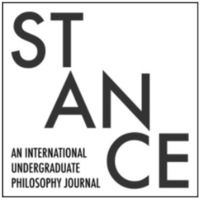
Stance: An International Undergraduate Journal
Stance: An International Undergraduate Philosophy Journal aims to enrich student learning by providing an opportunity for undergraduate students to have their original, scholarly work reviewed by and published in a peer-reviewed academic journal. Stance is produced and edited entirely by undergraduate students, for undergraduate students.
For more information about Stance, go to: https://www.stancephilosophy.com/
Promoting Dual Language Immersion
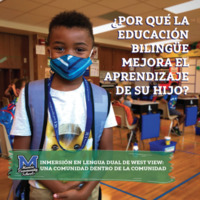
Advanced Spanish students at BSU (SP305, SP404, SP340) collaborated with elementary schools at two community school districts to promote their dual language immersion (DLI) programs. BSU students explored the state of bilingualism in the U.S. and the benefits of programs such as DLI that enable students to develop proficiency in both Spanish and English, strengthen academic learning and achievement, and cultivate intercultural sensitivity. The final community products include:
1) ten-week virtual reading/mentoring sessions in Spanish for 2nd graders in a DLI program;
2) design and production of promotional materials to inform potential parents about DLI programs and their benefits;
3) translation into Spanish several procedure and policy documents for DLI so that these materials are accessible to Spanish-speaking families.
A Community Intervention: Interprofessional Experiences Addressing Healthy Eating and Physical Activity at Cardinal Wellness
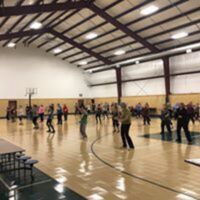
Health Science 302 and 494 are courses that include senior majors completing their final semester of coursework before beginning their internships. The courses seek to highlight the skills necessary to delivery health education programs in a variety of settings, where micro-level (interpersonal interactions) and macro-level (organizational and mass-media) applications are emphasized. Many of the course objectives are achieved in the context of a semester-long group project, where each student is asked to identify a health problem and an appropriate audience, for which they develop a social marketing-driven health campaign. For the past ten years of implementation of the courses, the students have been asked to choose problems that fit within Healthy Campus 2020 objectives, focusing their efforts on problems relevant to college students on Ball State’s campus specifically. However, in reviewing the primary objectives of the course, an understanding of how to tailor strategies and messages to specific diverse populations as well as the importance of advocacy for protection and promotion of the public’s health at all levels of society are often difficult to complete within the boundaries of a college student audience for messages.
To respond to this challenge, across the fall semester, the students (36 in total) were asked to take part in an immersive learning experience where the primary audience were community members from the Cardinal Wellness program, and the health problems were selected based upon what was most relevant to the community. As part of their work, the students were embedded in a full community-based participatory research project directed by the interests of community members. We spent the early part of the semester discussing theoretical and practical foundations of community-based participatory research in public health settings in online live lectures. Due to the online delivery of instruction in the course and the absence of in-person “live” classes at Cardinal Wellness, the students weren’t able to complete observation hours on-site at the program. However, in lieu of this contact, the students were asked to listen to the taped recordings from two previous focus groups with Cardinal Wellness members. We then worked together in live lecture to devise a shortened list of health topics that seemed meaningful and matched to the interests of Cardinal Wellness members. From that list, each student selected a specific topic, discussed as relevant by community members, for their larger course project.
After students ranked their own interests, we created groups (unifying students around shared topics) that worked together to create their community-based social marketing plan. The eight topics included removing the stigma of menopause, incorporating at-home exercises in front of the television, clean eating on a budget, using grocery lists to guide healthy food purchase, food safety and cross-contamination, cervical cancer awareness, colon cancer screening and awareness, and safe sex practices for middle- and older-aged adults. The plans were required to integrate community viewpoints as much as possible, including the use of focus group recordings and observations from the program’s social media site. The students also recruited for and conducted eight virtual focus groups with community members in early November. Cardinal Wellness participants were recruited using the program’s Facebook page and were compensated $10 for their participation, with eight different Cardinal Wellness members participating across groups. The groups were entirely orchestrated by students, including all communication with community members, moderation of the focus group, and coordination of compensation.
At the completion of the course, each student group was asked to orally present their written integrative summary. The summary featured a complete social marketing plan based on their insights from the focus groups, including an environmental analysis, problem analysis, target audience analysis, logic model featuring program goals and objectives, message design and positioning/branding justification, partnership analysis, and three required media deliverables. These included the storyboard for one video public service announcement, five social media posts, and one print material (a billboard, flyer, brochure, etc.).
The programs created as part of the class projects were implemented across the spring semester at Cardinal Wellness. Students in HSC 302 (Program Planning II – 24 students total) were asked to implement the social marketing programs designed by the 494 students, as part of the next integration of the Immersive Learning grant. In that, the social media content was published on the program’s Facebook page and print materials were distributed on site at Cardinal Wellness by students in the course during brief educational sessions.
Spring 2021 HSC 302 Students:
Hollyn Anderson, Brooke Cummins, Sarah Craft, Kaylen Underhill, Catie Ridley, Kayce Ingram, Emily Jones, Emily Gerbhardt, Jessica Guzman, Jessica Gilmore, Mackenzie Mundy, Nia Kimbrough, Camesia Davidson, Trinity Lee, Sydney Cardenas, Nikki Jennings, Sydney Sisson, Kaitlynn McIntyre, Morgan Friend, Olivia Supancik, Esther Grussing, Briana McCoy, Aerial Simmons
Midwestern Stories

Midwestern Stories
Midwestern Stories is a two-course series that has taken place in the Department of English in the fall and spring semesters of 2020-21. It has focused on student investigation of representations of Midwestern identity in various types of media. Indiana Humanities’ One State/One Story novel pick for 2020, Jean Thompson’s The Year We Left Home, has been central to Midwestern Stories’ thematic core. The novel engages and challenges popular narratives of the Midwest, including 1) that of a past in which agriculture and industry thrived and people were fulfilled by their participation in building America and 2) that of the contemporary Midwest as a stagnant milieu with little to offer the next generation. Paralleling these two popular narratives of the Midwest, the first course of Midwestern Stories focused on representations of the Midwestern past while the second focuses on the Midwestern present.
Midwestern Stories: Complicating the Mythic Landscapes of Farm and Factory
Students in the first course gained an expanded view of the agricultural and industrial Midwestern past and explored the kinds of stories that are left out of the popular idealization of farm and factory in the American imagination through the study of contemporary Midwestern novels. To learn about the experiences of real Midwesterners in past decades, students in the first course conducted an oral history project, interviewing older Midwesterners willing to share their recollections of life in the Midwest of the 1940s, 50s, 60s, 70s, 80s, and 90s. Based on these interviews, students worked together to compose and record a podcast that was then produced by the university’s Digital Corps. In nine episodes, the Stories from the Heartland podcast shares the stories of older folks from the often-mythologized middle of the country to challenge misconceptions and expand understanding of the Midwestern past.
Midwestern Stories: Constructing Our Contemporary Identity
The second course shifted students’ attention from the past to the present, focusing on representations of the contemporary Midwest in a variety of cultural texts. Through conversations with numerous guest speakers from multiple disciplines, students learned about the diverse experience of living in the Midwest and considered the stakes of employing a regional perspective. Students then worked alongside staff at Minnetrista Cultural Center in Muncie to develop a museum exhibit focused on Midwestern identity. Through a series of stories, the exhibit invites visitors to take a fresh look at a familiar space, exploring the complex landscape that is alternately celebrated as America’s Heartland and derided as “Flyover Country.” In addition to the Minnetrista lobby exhibit, students created a digital version of the “Midwestern Stories." Web content includes expanded explorations of stories shared in the physical exhibit, full access to the oral history podcasts developed in the first course and book reviews.
Philosophy Outreach Project
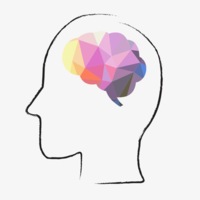
Philosophy Outreach Project
The Philosophy Outreach Project gets high school students across Indiana thinking.
POP creates alternative spaces for learning in classrooms, clubs, online, and conference settings. By curating philosophical content and fostering philosophical discussion, POP provides high school students with tools and a platform to engage with each other and the world.
POP is run by three teams of Ball State students with a variety of different interests and backgrounds. POP's team includes students studying philosophy, psychology, English, communications, criminal justice, and more.
This diversity of interests and knowledge allows for an impressive level of collaboration, which is ultimately what makes POP successful in promoting and facilitating pre-college philosophy.
For more information about POP, check out our website.
Glass Design: Technology & Industry
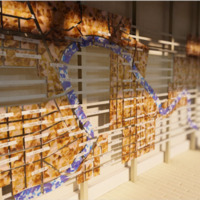
GLASS DESIGN: TECHNOLOGY & INDUSTRY
A new transdisciplinary immersive learning class that exposed and explored technological advances in the renowned regional glass industry. Students and faculty from the School of Art and the Department of Architecture engaged in material research, interviews and insights from leaders in glass industry, award winning public artists, and local community arts leaders. Students' research led to the development of multiple new ‘Donor Wall’ proposals for Minnetrista Cultural Center as well as rethinking design objects in the era of a pandemic.
Building Better Neighborhoods Identity Design

The City of Muncie has diverse communities with friendly people, interesting past, and outstanding cultural amenities that make it a desired place to live, do business, and to visit. Until Spring 2019, a lot of the neighborhoods in Muncie were lacking proper visual identification. A strong visual identity was needed to elevate the image of the neighborhood as well as provide a sense of pride within the residents.
In partnership with Building Better Neighborhoods and Muncie Action Plan, we worked with a core group of committee members from various Muncie Neighborhoods to develop their visual identity. Check out the other neighborhood identities at the Studio 165+ website: www.studio165plus.com/bbn
Riverside-Normal City Local District Survey
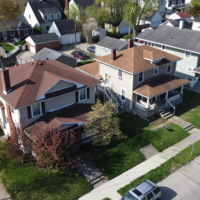
Professor Halls' class surveyed 91 properties in the district to determine their historic status and to update existing information from the national register of historic places. Research was conducted on the history of the neighborhood and on individual structures culminating in a document that will help provide necessary information to the Riverside-Normal City Neighborhood Assocation and the Muncie Historic Preservation and Rehabilitation Commission.
Credit to:
Cooper Shields
Robert Jonet
Caitlin Lehman
Nancy Jones
Haley Swindle
Bei Liu